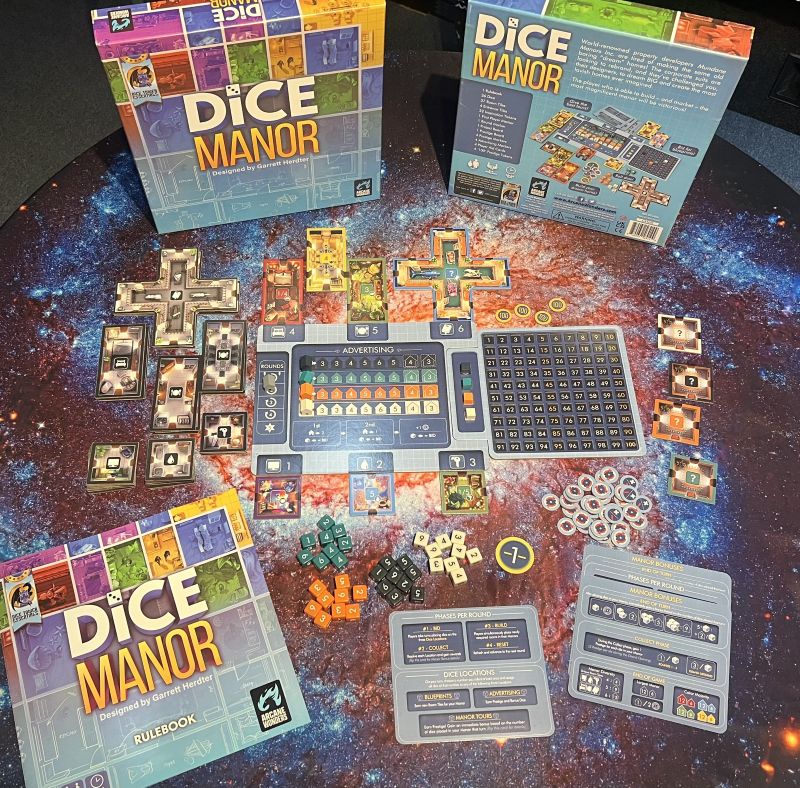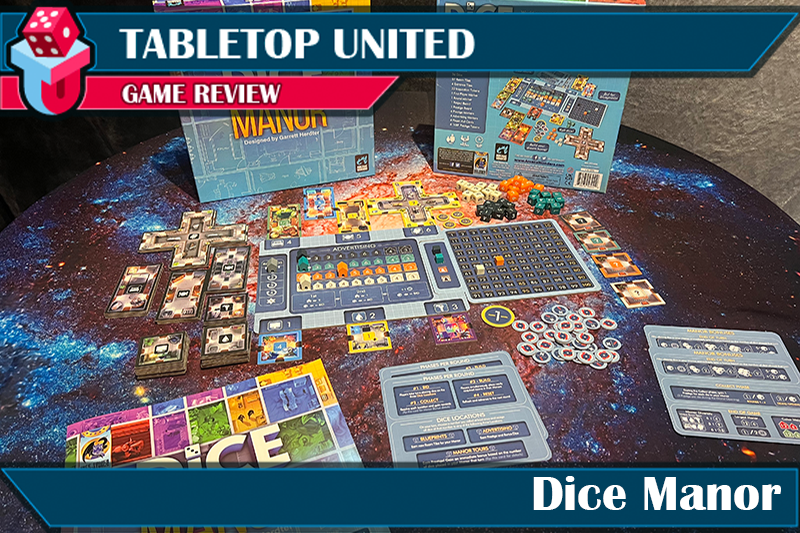
DICE MANOR
Designer: Garrett Herdter
Artist: Roomie Gontaruk and Danien Mammoliti
Publisher: Arcane Wonders
Year Published / Kickstarted: Published 2023
No. of Players: 2-4 Players
Ages: 14+
Playing Time: 30-45 Minutes
Main mechanic / Theme: Auction/Bidding, Dice Rolling, Tile Placement
Dream big, build big or go home because the player who is able to build and market the most magnificent manor will be victorious!
If you liked this review, please consider joining us on our social pages or subscribing to our newsletter.
FB Community: https://www.facebook.com/groups/ttucommunity/
Instagram: https://www.instagram.com/tabletop_united/
Newsletter: https://dashboard.mailerlite.com/forms/1001680/142036346614055988/share
Overview:
Mundane Manors Inc. is looking for a new Chief Inspirational Officer for their home building company. The player who is able to build and advertise the most prestigious and lavish mansion by the Grand Opening date is the winner.
Dice Manor is a dice rolling, set collection, tile placement game that is played over 4 building/advertising rounds and a Grand Opening Tour round.
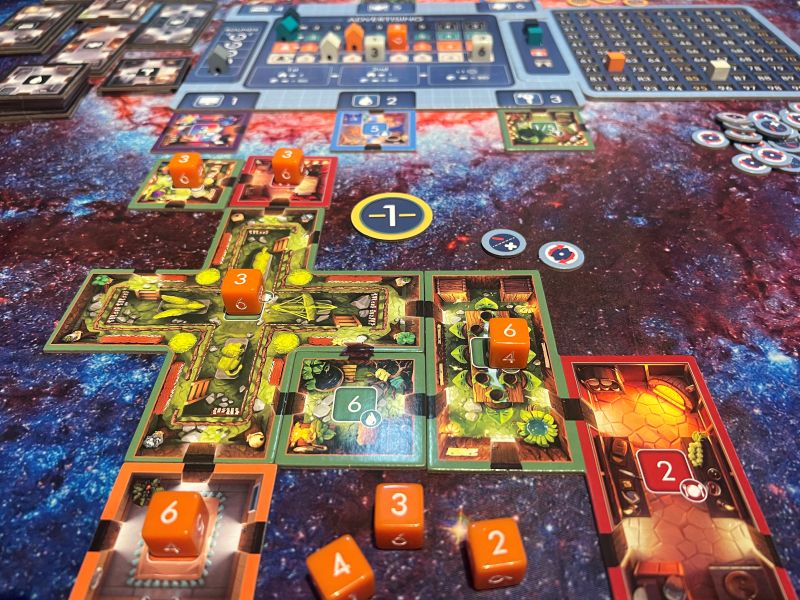
To check out Dice Manor, click on the link to view the publisher, Arcane Wonders’, website:
https://www.arcanewonders.com/product/dice-manor/
For more information about Dice Manor, click on the link to learn more on Board Game Geek:
https://boardgamegeek.com/boardgame/368517/dice-manor
Disclaimer: The publisher, Arcane Wonders, provided a published copy of the game for review.
Main Mechanics / Theme:
Roll your dice and group all of your matching numbers. Use one of those groups to place bids on blueprints, invest in advertising for your mansion, or give an early tour of your manor. Earn rooms for your manor, prestige points or bonus dice based upon your winning bids. Play continues for 4 bidding rounds until the 5th round, the Grand Opening Tour Round, where guests get to tour your mansion. During game play, all of these actions build prestige for your mansion, and the manor with the most prestige at the end of the grand opening, is declared the winner.
The main game components, the Project Board and Prestige Board, are interlocking and are placed in the center of the game play area. There are 6 different Room Tiles that are shuffled and placed in individual stacks next to the Project Board. The room tiles are: library tiles, dining & kitchen tiles, large bedroom tiles, small bedroom tiles, bathrooms and office tiles. Although the room tiles have specific shapes and categories, they are randomly colored which effects scoring at the end of the game. The top tile of each pile is dealt to the correct location around the Project Board. Prestige markers, for each player, are placed at the starting location on the Prestige Board, as well as, the advertising markers, for each player, and the round marker set on the first round.
Each player is given an entrance tile, a player aid tile and 9 dice of the color that they selected. Two of those dice are placed on their corresponding places on the advertising track to be earned as bonus dice during gameplay. Inspiration tokens are placed in a pool next to the playing area. Each player is given 2 starting inspiration tokens. A first player is determined and is given the first player marker. The competition is ready to start!
Each round had 4 phases. There is a bid phase, collect phase, build phase and a reset phase.
During the bid phase players roll their dice, group them into matching sets and use those sets to bid on blueprints or advertising for their manor. For example, a player rolls their initial 7 dice and receives the following roll and places them into these matching groups: 1 six, 2 fives and 4 fours. They can use one of these groups to bid on certain blueprints or invest in advertising. Each room tile type has a designated number that corresponds to the number on the dice. A player can place that group of that die number onto the matching number on the blueprint or they can take a matching set of dice and place them into the advertising square that is available to them. After placement, the next player rolls. Rolling continues until all of the players’ dice have been exhausted. If a die cannot be used for blueprint bidding or advertising, the player has the option to give an early manor tour. They can place the die onto the matching number of the room tile in their mansion, starting with the entrance tile. However, an entire grouping of dice must be used or they are discarded and cannot be used for the remainder of that round. All entrance tiles are considered wild, so any die can be placed there.
To win the blueprint for a room, you must be the player with the greatest number of matching dice in that particular bid area. If you have the most dice, at the end of the round, you win that room. Players are able to win multiple blueprints each round providing that they meet the win conditions for each room. If you did not win that room, but placed a bid, you receive an inspiration token which will be explained at the end of this section.
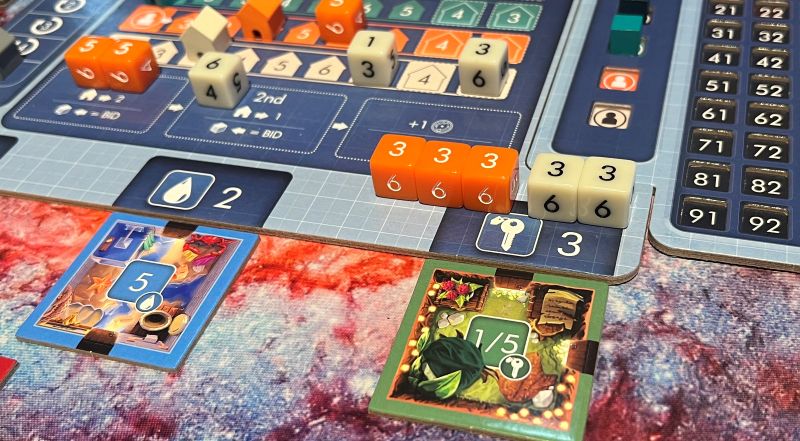
For example, room 3 is the large bedroom blueprint. Player one has placed 3 dice with a three on them, and the other player only placed two dice with three on them. Player one wins the room and player 2 receives an inspiration token for their efforts.
To gain advertising for your manor, you can place your bidding dice on one of the 3 sections designated for advertising. Placing dice and winning is based on the same methods used to bid on a blueprint. The player with the highest bid gets the highest reward while second and third places get their respective outcomes. Winning advertising allows you to move your advertising tracker forward a certain number of spaces, and their bonus die move as well. When the advertising marker and the bonus die meet on the advertising track, the bonus die can immediately be used by the player on future rolls.
Inspiration tokens are two-sided. One side allows a player to add or subtract a number from a die where six can be changed to a one and vice-versa. The flip side allows a placer to have a reroll.
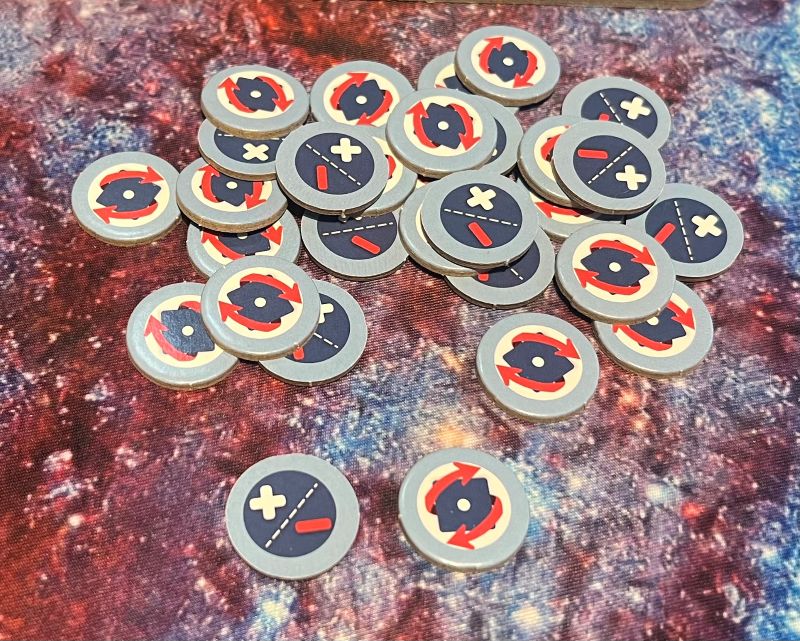
At any time, if a player cannot place a die or dice onto the advertising board or to bid on a room tile, they can use a group of dice to give an early tour of their manor provided that all of their numbered dice can be used; they start at the entrance, and they continue a linking chain starting from the entrance. One die in the manor earns a player an inspiration token while consecutive dice scores them prestige points.
Any die that cannot be use is considered lost - a dissatisfied customer - for that round. For example, Player 1 has 4 dice remaining and is choosing to give an early tour because they do not have enough dice for advertising or room blueprints and has rolled 2 twos, and 2 fours. The entrance tile is wild and the connecting room to the entrance has a 6 on it. They can only use one of those dice to place on the entrance, and because they did not roll 2 sixes, one of the twos or one of the fours would be removed for the remainder of that round.
After the bidding phase is the collection phase. Rooms that have been won are collected by their respective players. Advertising is resolved where the advertising marker and bonus die are moved, prestige points are awarded for all players or inspiration tokens are distributed. Colored dice are returned to their respective players to be used in the next round.
Next is the build phase where all players, simultaneously, build their manors with the rooms of the blueprints that they have won. However, players have to be cognizant to where the doorways are placed when placing a new room tile into your manor. All room doorways must connect and match.
Lastly is the reset phase. All of the unpurchased rooms are discarded and replaced with the designated room of the matching symbol from the piles next to the advertising board. The round marker is advanced to the next stage, and the 1st player marker is passed to the next clockwise player.
Play continues for 4 rounds of bidding and auction until the Grand Opening stage, round 5.
During the grand opening phase, the ability to bid on room blueprints, gain advertising, prestige, or earn bonus die has ended. Now is the time to showoff your constructed manor.
Players are rolling their dice and grouping them in matching numbers as done in previous rounds. Each room tile has a number or 2 numbers on them. Using the matching grouped dice, players start at the entrance, which is wild, and place that group on room tiles matching the number on the room. Dice must make a continuous path linking up with an already placed die. Dice cannot be randomly placed in the manor. Any unused dice, from that grouping, are considered unsatisfied customers, and those dice are removed from the game. The unused, ungrouped dice are returned into the player’s hand. The grand opening tour continues until all players' dice have been used in the tour or removed as unhappy tour guests.
Final scoring takes place after the grand opening tour. Players earn prestige points for the amount of dice that were placed in their manor. Players are also awarded bonuses for having a certain number of room types, color of rooms, the largest manor and color majority of rooms.
The player with the most prestige points is considered the winner, the new CIO, Chief Inspirational Officer, of Mundane Manors Inc.
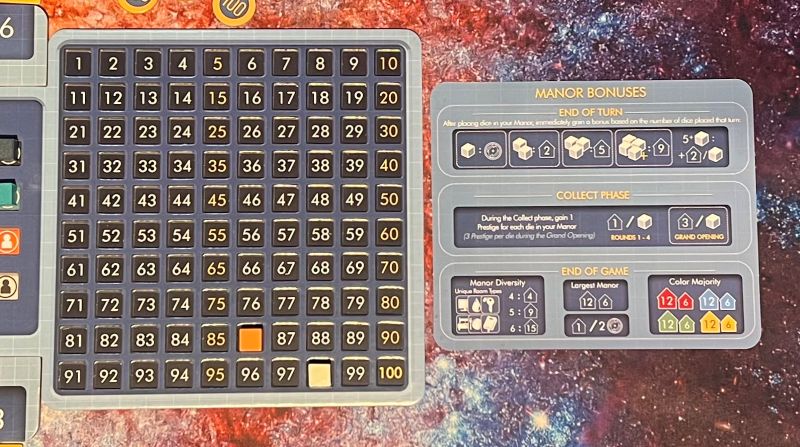
Theme, Artwork and Illustration, Graphic Design and Layout:
First, I must say the layout of the game board is simple and really works. How the prestige board interlocks with the advertising board works really well to cut down on costs of a larger gameboard, and provides buyers with a lower purchasing cost for this game without having the additional costs of a game with multi-folding, sectional game boards.
Each room tile has its own artwork theme that adds to the fun of this game. I am referring to having a library room tile with a wild game theme paired with an office tile that has a plant theme attached to a dining room with a beach theme. While these themes do not technically have much to do with scoring, other than color of the room type, it adds a lot of fun of the game while planning rooms. Many of the players that I played this game with have made comments of, “I really want this type of room.”
The rulebook is very colorful and helpful when trying to learn to play the game. It was very concise, but answered all questions towards gameplay.
The layout of the door placement and where rooms can connect to each other added a nice challenge to the build phase in the game.
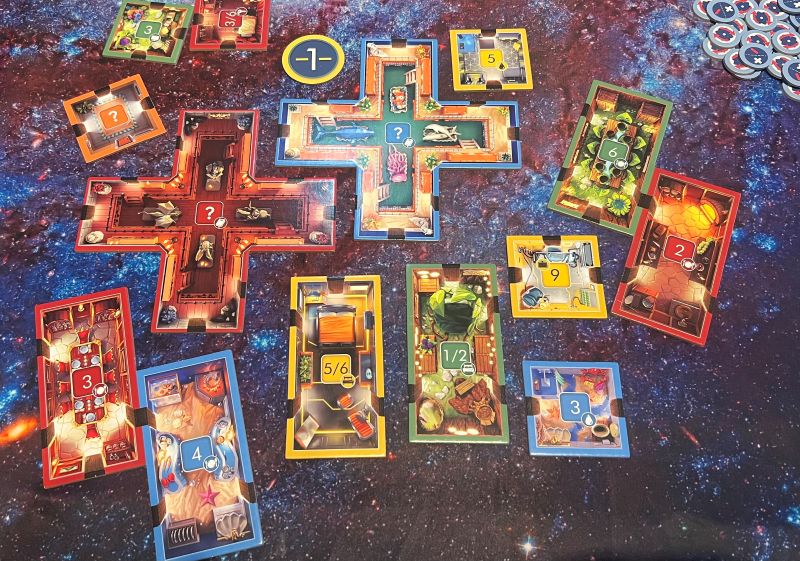
Inclusivity and Accessibility:
This game does require players to determine colors with the advertising tracking, the room colors, prestige point tracker and the dice colors. Knowing where your advertising tracker is located remedies having any color sensitivity or color blindness. However, while each room type has a specific symbol designated to it, room colors are randomly assigned, so people who are color blind or have color sensitivity will have a difficult time, without assistance, determining these factors. Also, the game requires players to be able to hold 7-9, average sized dice at one time. Most of the gameplay is in front of the player other than having to reach to retrieve your won blueprint room and placing bidding dice.
The rulebook uses large fonts for easy reading.
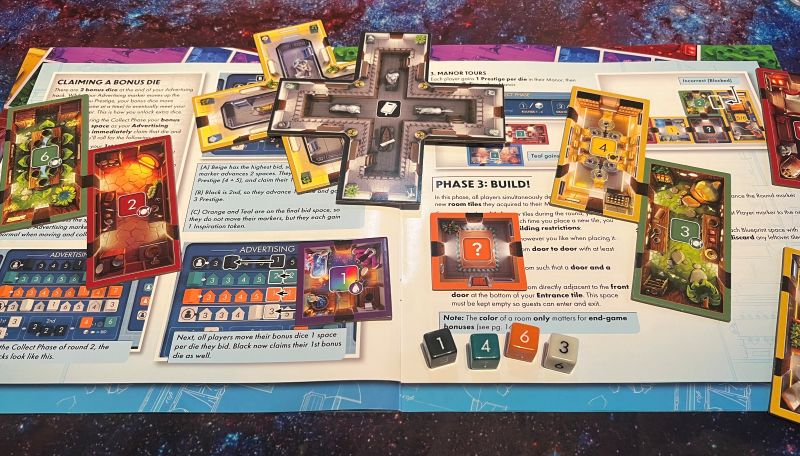
What Worked:
The game is played over 5 quick rounds. The box reads 30-45 minutes and most of the games I have played were with 2 or 3 players and were about 35 minutes. While this game is a lighter game with a lower complexity rating (1.86/5), it feels slightly like a more complex, medium-weight game that plays quickly.
Turns from one player to the next, flow quickly without much downtime from planning.
The assigned numbers on the rooms create enough fun strategy when bidding on rooms and building them in your manor. You have to plan where numbers are placed during rounds 1-4 because it will affect your Grand Opening Tour during Round 5.
The bidding phase of each round becomes competitive when trying to win certain rooms, advertising or bonus dice.
Scoring works great because there are many opportunities and methods of earning prestige points. There was never really a game where someone was so far behind that they never were capable of catching up with other players. Most of the games I played were relatively close.
The rulebook was easy to understand and provided many examples and scenarios.
The game is easy to learn and easy to teach new players.
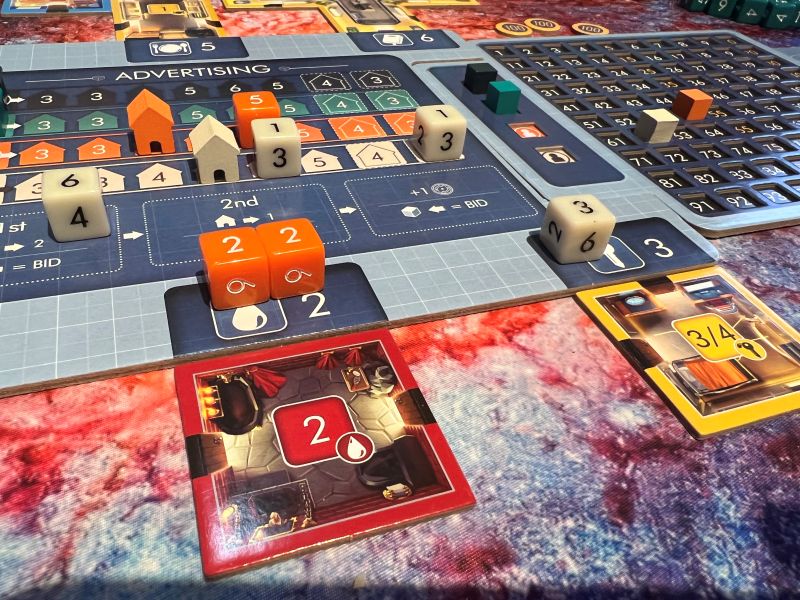
Final Thoughts:
The game is very fast-paced, fun and competitive. It is a quick game that can be enjoyed by seasoned gamer veterans, and by those new to the hobby. Sometimes the games were so fast that you almost feel like there should be an additional round before the Grand Opening Tour.
Dice Manor is very thematic and the room tiles capture the theme of building a lavish home successfully.
While I own other games that involve bidding and auctioning, Dice Manor is different than any game that I have in my collection. It keeps those mechanics fresh on the game table.
While the game does rely on the luck of dice rolls, there is some dice mitigation and modification by using inspiration tokens. There is a deal of strategy where your ideas and plans can change after other player’s turns.
The game does have a larger table footprint. The unnecessarily large tiles of some of the rooms take up a lot of space while the game boards are appropriately sized.
The components of this game are of high quality. Even with rolling a larger number of dice, they feel great in your hands. The advertising board, prestige board and game tiles are very thick and have a nice finish.
Fans of dice games and bidding would enjoy this game. Those that want an easy game to learn for game night with new players should consider Dice Manor. It brings dice rolling and auctioning to a new, fun and highly competitive level.
